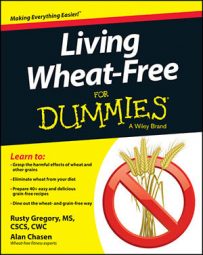You are not eating your grandfather’s wheat. The days of wheat blowing tall in the wind are gone. Dwarf and semi-dwarf wheat (shorter varieties created to help combat world hunger) comprise more than 99 percent of the wheat worldwide.
Wheat that once grew wild can now only grow with human support from pest controls and fertilizers, leaving an inferior product that doesn't resemble what earlier generations ate when they were young. Wheat has changed so much through the years that “the staff of life” is anything but.
Going back to wheat's roots
Though the modern version of wheat has been around since the early 1960s, history shows that humans have been eating the original wild version going back 10,000 or 11,000 years. In fact, the Middle East (primarily southeast Turkey) can claim early dibs on this crop.
The ancestor of modern wheat was known as einkorn. The Natufians, who roamed much of the Middle East, made use of not only einkorn but also wild cereals and rye. The climate in the area allowed them to cultivate the seeds and plan for the long term.
Most people at that time were hunters and gatherers, but the Natufians used the wheat as a staple, and it helped them thrive and create the first settlements.
Spelt arrived on the scene around the fifth or sixth century BCE; because of its wild grass parents, it had a superior adaptability to its wheat predecessors.
Finally, the early wheat varieties concluded with triticum aestivum, also known as common bread wheat. Today's wheat is in this form, even though triticum aestivum originally appeared about 1700 BCE.
Milling away the nutritional value
Wheat remained relatively the same until the population explosion after the end of the Napoleonic Wars in 1815. In their desire to make chemical fertilizers, European chemists inadvertently poisoned the soil because they didn't understand the science of what they were doing.
Through the 19th century, more wars, a potato blight, and a cholera epidemic resulted in food shortages in France and England.
America was in a perfect position to take advantage of Europe's needs. Thanks in part to George Washington, wheat was readily grown and cultivated with superior crop rotations and fertilizers. (Crop rotation refers to Washington's seven-year plan to vary the crops planted and keep the soil nutrient dense.)
His methods also increased the wheat yield. With new techniques and virgin soil, America was off and running in the export business. By 1860, America was exporting millions of bushels of wheat to many parts of the world.
The increased demand and the advent of the industrial age reduced the cost of production for many foods, whether by speeding up the process or using cheap ingredients. Many times these ingredients were items such as aluminum sulfate or wood shavings that were downright dangerous. The need for longer lasting flour led grain producers to remove the outer bran and germ layer, which contain most of the nutrients.
The impact of the commercial bakers loomed large because times were changing. In America, for instance, 70 percent of all bread eaten in 1910 was baked at home. By 1924, that figure was 30 percent. By 1930, Wonder Bread came sliced and in a protective wrapper.
The highly processed bread was enriched with vitamins and minerals to help fight deficiency conditions, especially those related to B vitamins. Wheat, which had once been a fairly nutritious grain, now required enrichment to achieve the level of quality that existed in the pre-processing era.
Today, wheat is bleached by using questionable ingredients to make better-tasting bread with a longer shelf life and a desirable texture. The end result is a low-nutrient-quality product whose ingredients have serious side effects.
Wheat's modified genetics increase yields
The processing involved with wheat is only part of the problem. In an effort to end world hunger in the mid-20th century, finding ways to increase grain yields became a priority. Norman Borlaug, who would eventually win a Nobel Peace Prize for his efforts, began using heavy amounts of nitrogen fertilizer.
To solve the problems caused to the plants by excess fertilizer, dwarf and semi-dwarf wheats were developed through genetic modification. The ability to feed the world was becoming a reality. However, a tradeoff of the new wheat strains is a much lower nutrient density.
In fact, these wheats have 20 to 30 percent less nutrient content than traditional wheat. Nutrients such as zinc, iron, magnesium, manganese, sulfur, phosphorous, and calcium are all affected. Scientists have been unable to decrease wheat's levels of phytates, which bind to nutrients and make them indigestible to humans. Nutrients otherwise measured in the grains may not be usable because of the phytates.
The modern dwarf wheat poses one other problem: It also contains much higher amounts of the genes for gluten, the protein associated with celiac disease. The hybridization that has taken place to achieve higher yields doesn't seem to be as clean as scientists thought.
See what’s used to process wheat
Many chemicals and other substances are used to mill and process wheat. Here’s a list of the most common ones used:
Ammonium chloride
Azodicarbonamide
Benzoyl peroxide
Calcium propionate
Chlorine dioxide
Dextrose
Diacetyl tartaric acid
Esters of mono and diglycerides
Gluten (extra added)
Potassium bromate
Sodium stearoyl 2 lactylate
Starch enzymes

